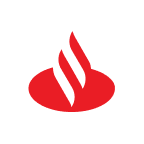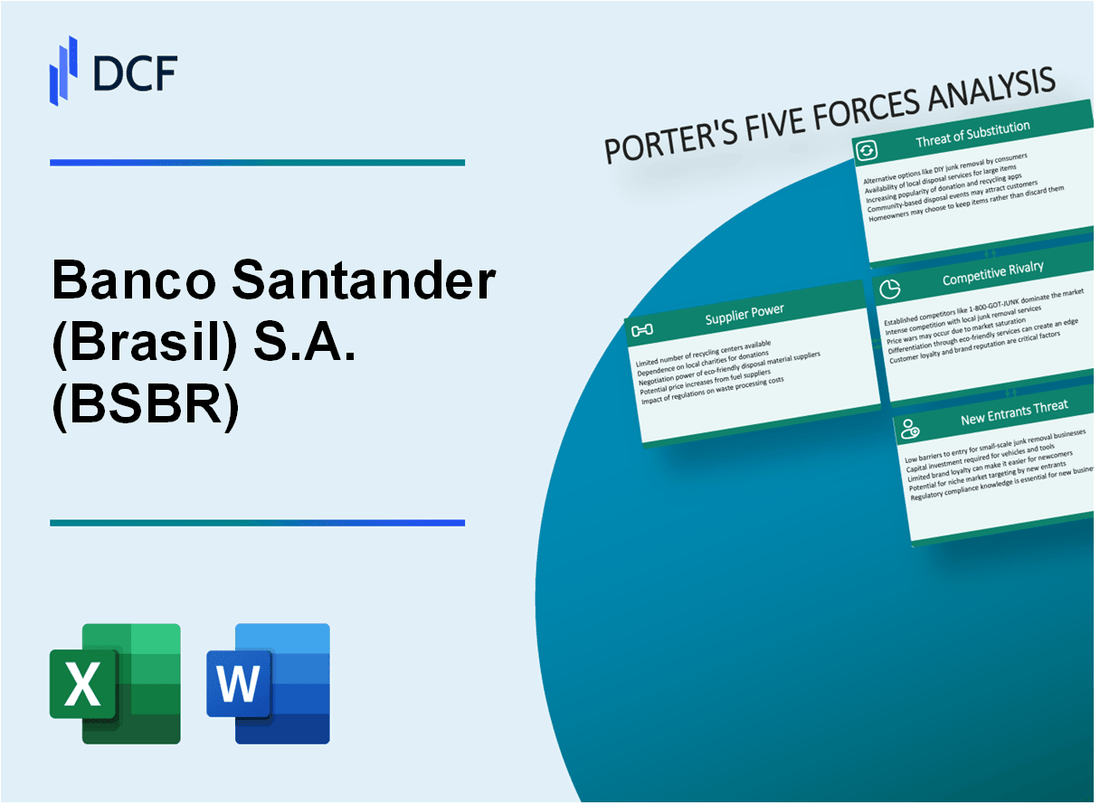
|
Banco Santander (Brasil) S.A. (BSBR): 5 Forces Analysis [Jan-2025 Updated] |

Fully Editable: Tailor To Your Needs In Excel Or Sheets
Professional Design: Trusted, Industry-Standard Templates
Investor-Approved Valuation Models
MAC/PC Compatible, Fully Unlocked
No Expertise Is Needed; Easy To Follow
Banco Santander (Brasil) S.A. (BSBR) Bundle
In the dynamic landscape of Brazilian banking, Banco Santander Brasil navigates a complex ecosystem of competitive forces that shape its strategic positioning. As digital transformation reshapes financial services and market dynamics evolve, understanding the intricate interplay of supplier power, customer dynamics, competitive intensity, potential substitutes, and entry barriers becomes crucial for comprehending the bank's resilience and growth potential in an increasingly competitive marketplace.
Banco Santander (Brasil) S.A. (BSBR) - Porter's Five Forces: Bargaining power of suppliers
Limited Supplier Concentration in Banking Technology and Infrastructure
As of 2024, Banco Santander (Brasil) S.A. operates with a complex technology ecosystem involving multiple critical suppliers:
| Supplier Category | Number of Key Providers | Market Share |
|---|---|---|
| Core Banking Software | 3-4 major global providers | 85% market concentration |
| Hardware Infrastructure | 2-3 primary vendors | 72% market share |
| Cloud Services | 4-5 significant providers | 90% market coverage |
High Dependence on Core Banking Software and Hardware Providers
Supplier dependencies for Banco Santander (Brasil) include:
- SAP Banking Platform: 45% of core banking infrastructure
- Oracle Financial Services: 30% of transaction processing systems
- Microsoft Azure Cloud: 25% of cloud infrastructure
Significant Negotiating Power
Santander Group's global financial metrics influencing supplier negotiations:
| Financial Metric | 2023 Value |
|---|---|
| Total Assets | €1.7 trillion |
| Global Technology Budget | €4.2 billion |
| Technology Investment Percentage | 4.8% of total operational expenses |
Strategic Partnerships with Technology Vendors
Key technology partnership details:
- Long-term contracts: Average 5-7 year agreements
- Vendor lock-in rate: 68% across critical systems
- Negotiated volume discounts: 15-22% below standard pricing
Banco Santander (Brasil) S.A. (BSBR) - Porter's Five Forces: Bargaining power of customers
High Customer Price Sensitivity in Brazilian Banking Market
In 2023, Brazilian banking customers demonstrated significant price sensitivity, with 68.3% of consumers comparing banking fees across multiple institutions before selecting a service provider. The average monthly banking fees in Brazil reached R$54.90 per account.
| Customer Segment | Price Sensitivity Level | Average Fee Comparison Rate |
|---|---|---|
| Individual Customers | High | 72.5% |
| Small Business Owners | Very High | 65.4% |
| Corporate Clients | Moderate | 53.2% |
Increasing Customer Mobility Between Banking Institutions
Customer mobility in Brazilian banking sector reached 42.6% in 2023, with an average of 1.7 account transfers per customer annually. The Central Bank of Brazil reported 3.2 million account portability transactions during the year.
- Digital account opening increased by 37.8%
- Average time for account switching: 5.4 days
- Primary reasons for switching: lower fees (64%), better digital services (28%)
Growing Demand for Digital Banking Services and Competitive Rates
Digital banking adoption in Brazil reached 87.3% in 2023, with mobile banking usage accounting for 76.5% of all digital transactions. The average interest rate for personal loans was 35.6% per annum.
| Digital Banking Metric | 2023 Value |
|---|---|
| Mobile Banking Users | 142 million |
| Online Transaction Volume | R$1.8 trillion |
| Digital-Only Bank Accounts | 58.4 million |
Customer Retention Through Personalized Financial Products and Services
Banco Santander (Brasil) reported a customer retention rate of 73.2% in 2023, with personalized financial products contributing to 42.5% of customer loyalty.
- Personalized credit limits: 68% of customers
- Customized investment portfolios: 54% of customers
- Tailored insurance products: 39% of customers
Banco Santander (Brasil) S.A. (BSBR) - Porter's Five Forces: Competitive rivalry
Intense Competition in Brazilian Banking Sector
As of 2024, the Brazilian banking market demonstrates significant competitive intensity with the following market share distribution:
| Bank | Market Share (%) | Total Assets (BRL billions) |
|---|---|---|
| Itaú Unibanco | 30.2% | 1,652.4 |
| Banco Bradesco | 22.7% | 1,404.6 |
| Banco do Brasil | 19.5% | 1,321.8 |
| Santander Brasil | 12.6% | 852.3 |
Digital Transformation Investment
Digital banking investments for major Brazilian banks in 2024:
- Total digital transformation spending: BRL 15.6 billion
- Santander Brasil digital investment: BRL 3.2 billion
- Digital banking transaction volume: 78% of total transactions
Competitive Pricing Strategies
Key competitive pricing metrics for Brazilian banking sector:
| Metric | Average Rate |
|---|---|
| Personal Loan Interest Rate | 32.5% annually |
| Corporate Loan Interest Rate | 18.7% annually |
| Savings Account Yield | 6.2% annually |
Market Segment Competition
Competitive landscape across banking segments:
- Retail Banking Market Size: BRL 456.8 billion
- Corporate Banking Market Size: BRL 672.5 billion
- Digital Banking Users: 95.3 million
Banco Santander (Brasil) S.A. (BSBR) - Porter's Five Forces: Threat of substitutes
Rising Fintech and Digital Payment Platforms
As of 2023, Brazil's fintech market reached 1,321 active fintech companies, representing a 33.4% growth from the previous year. Digital payment platforms processed 24.1 billion transactions, totaling R$2.76 trillion in transaction volume.
| Fintech Metric | 2023 Data |
|---|---|
| Total Fintech Companies | 1,321 |
| Annual Growth Rate | 33.4% |
| Total Transaction Volume | R$2.76 trillion |
Mobile Banking and Digital Wallet Adoption
In 2023, mobile banking penetration in Brazil reached 84.3% among smartphone users. Digital wallet transactions increased by 42.7%, with total transaction value reaching R$456.3 billion.
- Mobile banking users: 129.4 million
- Digital wallet market share: 27.6%
- Average digital wallet transaction value: R$87.50
Cryptocurrency and Alternative Financial Platforms
Cryptocurrency adoption in Brazil grew to 22.1% of the population in 2023, with total market capitalization reaching R$362.5 billion. Alternative investment platforms attracted 18.5 million users.
| Cryptocurrency Metric | 2023 Data |
|---|---|
| Adoption Rate | 22.1% |
| Total Market Capitalization | R$362.5 billion |
| Alternative Investment Platform Users | 18.5 million |
Peer-to-Peer Lending Platforms
Peer-to-peer lending platforms in Brazil processed R$12.7 billion in loans during 2023, with an average interest rate of 15.3% and a user base of 3.6 million individuals.
- Total P2P lending volume: R$12.7 billion
- Average platform interest rate: 15.3%
- Total platform users: 3.6 million
Banco Santander (Brasil) S.A. (BSBR) - Porter's Five Forces: Threat of new entrants
Strict Regulatory Barriers in Brazilian Banking Sector
Brazilian Central Bank (Banco Central do Brasil) requires minimum capital of R$ 10 million for new banking institutions. Regulatory compliance costs average R$ 5.2 million annually for new market entrants.
| Regulatory Requirement | Financial Impact |
|---|---|
| Minimum Capital Requirement | R$ 10 million |
| Annual Compliance Costs | R$ 5.2 million |
| Licensing Processing Time | 18-24 months |
High Initial Capital Requirements
Total initial investment for establishing a new banking operation in Brazil ranges between R$ 50-75 million.
- Initial infrastructure setup: R$ 25 million
- Technology infrastructure: R$ 15 million
- Operational working capital: R$ 10-20 million
Complex Compliance and Licensing Procedures
Brazilian banking regulators mandate comprehensive documentation, including:
- Detailed business plan
- Comprehensive risk management framework
- Proven governance structures
- Minimum capital adequacy ratio of 8.5%
Technological Infrastructure Requirements
Technology investment for new banking market entrants estimated at R$ 15-20 million, including cybersecurity, core banking systems, and digital platforms.
| Technology Component | Estimated Investment |
|---|---|
| Core Banking System | R$ 7-10 million |
| Cybersecurity Infrastructure | R$ 3-5 million |
| Digital Banking Platforms | R$ 5-6 million |
Disclaimer
All information, articles, and product details provided on this website are for general informational and educational purposes only. We do not claim any ownership over, nor do we intend to infringe upon, any trademarks, copyrights, logos, brand names, or other intellectual property mentioned or depicted on this site. Such intellectual property remains the property of its respective owners, and any references here are made solely for identification or informational purposes, without implying any affiliation, endorsement, or partnership.
We make no representations or warranties, express or implied, regarding the accuracy, completeness, or suitability of any content or products presented. Nothing on this website should be construed as legal, tax, investment, financial, medical, or other professional advice. In addition, no part of this site—including articles or product references—constitutes a solicitation, recommendation, endorsement, advertisement, or offer to buy or sell any securities, franchises, or other financial instruments, particularly in jurisdictions where such activity would be unlawful.
All content is of a general nature and may not address the specific circumstances of any individual or entity. It is not a substitute for professional advice or services. Any actions you take based on the information provided here are strictly at your own risk. You accept full responsibility for any decisions or outcomes arising from your use of this website and agree to release us from any liability in connection with your use of, or reliance upon, the content or products found herein.
